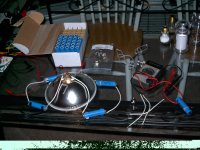ahambone
10 W
- Joined
- Oct 6, 2008
- Messages
- 71
I mentioned earlier over in the "even newer 24 channel BMS" board that I would be getting in a sample set of HWC 18650 format cells for testing in an EV project. I have received my cells and have had a little time to tinker with them. The cells are available online at Volts Phreaks - a distributor apparently already popular with other forum members for their isolated chargers. I was attracted to these cells because that vendor has a good price break when purchasing over 50 units. My end goal is to possibly use these cells as the traction pack for a converted VW Cabriolet (more details on that can be found over on my project blog).
I would like some input from the other members of this forum on the best ways to test and document the performance of these cells for me and other users of this forum. How do people normally load-test cells? I would like to "verify" in some way that these cells do perform close to their 1.4 ah rating. How do I test that? Is it as simple as (1) charge to capacity, (2) place a known load on some set of cells, (3) watch the voltage and amps over time, (4) chart + graph the data at fixed time intervals, (5) repeat for many cells?
Here is a shot of the cells as delivered:

I only have 2 relatively cheap volt/ammeters (one digital, one analog) at my disposal for making measurements. I do have a 5.5 amp load I can put on the batteries, as shown in the second picture here.

Here is my first impression of these cells:
These cells the come with no warranty (as they are intended for engineers). To me that means there is a nonzero failure rate for them and they must all be tested upon arrival. In general, LiFePO4 batteries shouldn’t be discharged below 2.5 volts and cells below 2.0 volts are often considered dead. Of the 80 cells delivered, 75 arrived with charges of 2.5 volts or higher. 4 came with charges of 2.0 volts to 2.5 volts. These cells perked up after a good sit on my home-made charger (an LM350 circuit). The last cell arrived at 0.6 volts and while it took a charge to 3.6 volts and then handled a load it had more thermal dissipation (read: it got hotter) that the other cells in it’s pack during testing did not present. I marked this cell bad. One bad cell out of 80 - that’s not too bad for "cheapo" cells.
Cheers,
--Adam
I would like some input from the other members of this forum on the best ways to test and document the performance of these cells for me and other users of this forum. How do people normally load-test cells? I would like to "verify" in some way that these cells do perform close to their 1.4 ah rating. How do I test that? Is it as simple as (1) charge to capacity, (2) place a known load on some set of cells, (3) watch the voltage and amps over time, (4) chart + graph the data at fixed time intervals, (5) repeat for many cells?
Here is a shot of the cells as delivered:

I only have 2 relatively cheap volt/ammeters (one digital, one analog) at my disposal for making measurements. I do have a 5.5 amp load I can put on the batteries, as shown in the second picture here.

Here is my first impression of these cells:
These cells the come with no warranty (as they are intended for engineers). To me that means there is a nonzero failure rate for them and they must all be tested upon arrival. In general, LiFePO4 batteries shouldn’t be discharged below 2.5 volts and cells below 2.0 volts are often considered dead. Of the 80 cells delivered, 75 arrived with charges of 2.5 volts or higher. 4 came with charges of 2.0 volts to 2.5 volts. These cells perked up after a good sit on my home-made charger (an LM350 circuit). The last cell arrived at 0.6 volts and while it took a charge to 3.6 volts and then handled a load it had more thermal dissipation (read: it got hotter) that the other cells in it’s pack during testing did not present. I marked this cell bad. One bad cell out of 80 - that’s not too bad for "cheapo" cells.
Cheers,
--Adam

